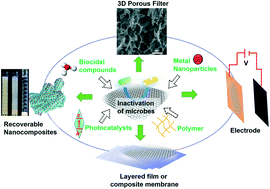当前位置:
X-MOL 学术
›
Environ. Sci.: Nano
›
论文详情
Our official English website, www.x-mol.net, welcomes your feedback! (Note: you will need to create a separate account there.)
Graphene-based antimicrobial nanomaterials: rational design and applications for water disinfection and microbial control
Environmental Science: Nano ( IF 7.3 ) Pub Date : 2017-09-25 00:00:00 , DOI: 10.1039/c7en00583k Xiangkang Zeng 1, 2, 3, 4 , Gen Wang 5, 6, 7, 8, 9 , Yue Liu 1, 2, 3, 4 , Xiwang Zhang 1, 2, 3, 4
Environmental Science: Nano ( IF 7.3 ) Pub Date : 2017-09-25 00:00:00 , DOI: 10.1039/c7en00583k Xiangkang Zeng 1, 2, 3, 4 , Gen Wang 5, 6, 7, 8, 9 , Yue Liu 1, 2, 3, 4 , Xiwang Zhang 1, 2, 3, 4
Affiliation

|
Antimicrobial nanomaterials for water treatment have attracted ever-growing research attention as they provide alternative approaches for disinfection and microbial control. Among all the antimicrobial nanomaterials, graphene-based nanomaterials have emerged recently. This review article seeks to provide a whole view on graphene-based antimicrobial nanomaterials particularly applied for water disinfection and pathogenic microorganism control. Herein, we firstly give a brief introduction of the antimicrobial characteristics of single-component graphene materials. In the following section, the functionalization of graphene with metal nanoparticles, photocatalysts, polymers and biocidal compounds for tailorable antimicrobial activities and microbial inactivation is thoroughly reviewed. In addition, innovative devices (hydrogel, thin film, composite membrane, recoverable nanocomposite and electrode) assembled from graphene-based nanomaterials used for water disinfection and microbial control are discussed in detail. Finally, the future opportunities and challenges of designing graphene-based antimicrobial nanomaterials for water disinfection are addressed.
中文翻译:

石墨烯基抗菌纳米材料:水消毒和微生物控制的合理设计和应用
用于水处理的抗菌纳米材料吸引了越来越多的研究关注,因为它们为消毒和微生物控制提供了替代方法。在所有的抗菌纳米材料中,最近出现了石墨烯基纳米材料。这篇综述文章旨在提供有关石墨烯基抗菌纳米材料的完整观点,这些纳米材料特别适用于水消毒和病原微生物控制。在此,我们首先简单介绍一下单组分石墨烯材料的抗菌特性。在以下部分中,将对石墨烯与金属纳米颗粒,光催化剂,聚合物和杀生物化合物的功能化进行全面综述,以实现可定制的抗菌活性和微生物灭活。此外,创新的设备(水凝胶,薄膜,详细讨论了由用于水消毒和微生物控制的石墨烯基纳米材料组装而成的复合膜,可回收纳米复合材料和电极)。最后,解决了设计用于水消毒的石墨烯基抗菌纳米材料的未来机遇和挑战。
更新日期:2017-10-17
中文翻译:

石墨烯基抗菌纳米材料:水消毒和微生物控制的合理设计和应用
用于水处理的抗菌纳米材料吸引了越来越多的研究关注,因为它们为消毒和微生物控制提供了替代方法。在所有的抗菌纳米材料中,最近出现了石墨烯基纳米材料。这篇综述文章旨在提供有关石墨烯基抗菌纳米材料的完整观点,这些纳米材料特别适用于水消毒和病原微生物控制。在此,我们首先简单介绍一下单组分石墨烯材料的抗菌特性。在以下部分中,将对石墨烯与金属纳米颗粒,光催化剂,聚合物和杀生物化合物的功能化进行全面综述,以实现可定制的抗菌活性和微生物灭活。此外,创新的设备(水凝胶,薄膜,详细讨论了由用于水消毒和微生物控制的石墨烯基纳米材料组装而成的复合膜,可回收纳米复合材料和电极)。最后,解决了设计用于水消毒的石墨烯基抗菌纳米材料的未来机遇和挑战。



























 京公网安备 11010802027423号
京公网安备 11010802027423号